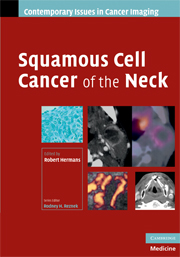Book contents
- Frontmatter
- Contents
- List of contributors
- Series Foreword
- Preface to Squamous Cell Cancer of the Neck
- 1 Introduction: epidemiology, pathology and clinical presentation
- 2 Radiotherapy and chemoradiotherapy of the head and neck
- 3 Surgery of the orocervical region
- 4 Laryngeal and hypopharyngeal cancer
- 5 Oral cavity and oropharyngeal cancer
- 6 Nasopharyngeal cancer
- 7 Neck and distant disease spread
- 8 Post-treatment imaging
- Index
- Plate section
- References
5 - Oral cavity and oropharyngeal cancer
Published online by Cambridge University Press: 24 August 2009
- Frontmatter
- Contents
- List of contributors
- Series Foreword
- Preface to Squamous Cell Cancer of the Neck
- 1 Introduction: epidemiology, pathology and clinical presentation
- 2 Radiotherapy and chemoradiotherapy of the head and neck
- 3 Surgery of the orocervical region
- 4 Laryngeal and hypopharyngeal cancer
- 5 Oral cavity and oropharyngeal cancer
- 6 Nasopharyngeal cancer
- 7 Neck and distant disease spread
- 8 Post-treatment imaging
- Index
- Plate section
- References
Summary
Introduction
Malignant tumors of the oral cavity and oropharynx are among the most common head and neck malignancies. Although many of these malignancies are clinically evident, others are not. In other cases, the patient presents with nodal metastases, and imaging is used to detect a primary cancer. In either case, imaging plays an integral role in the staging evaluation of these patients, as well as in their post-treatment work-up. This chapter will review the spectrum of imaging findings for malignant tumors of the oral cavity and oropharynx. The focus will be on the initial imaging evaluation, not post-treatment. Imaging of cervical lymphadenopathy will be covered in Chapter 7.
Choice of modality and technique
The choice of the most appropriate imaging modality remains controversial, or at least influenced by regional and institutional preferences. In some centers, imaging of the oral cavity and oropharynx is conducted primarily with magnetic resonance imaging (MRI). The emergence of position emission tomography (PET) and PET linked with computed tomography (CT) has changed that equation somewhat, but at the moment, few would argue that PET/CT should be the sole imaging modality for these lesions. However, in our institution, unless there is a contrast allergy or renal dysfunction preventing the use of iodinated contrast material, it is our preference to use CT. This preference is based on the consistent and reproducible high-quality images that can be expected from CT, its relatively lower cost and short acquisition time and, with newer, multidetector scanners (MDCT), the availability of multiplanar images.
- Type
- Chapter
- Information
- Squamous Cell Cancer of the Neck , pp. 67 - 93Publisher: Cambridge University PressPrint publication year: 2008

